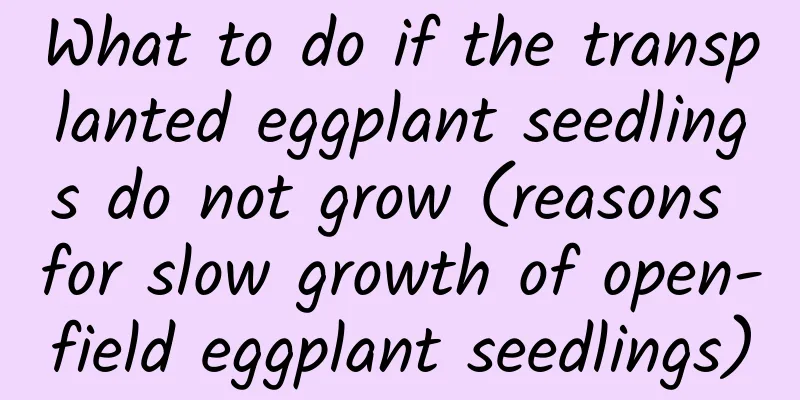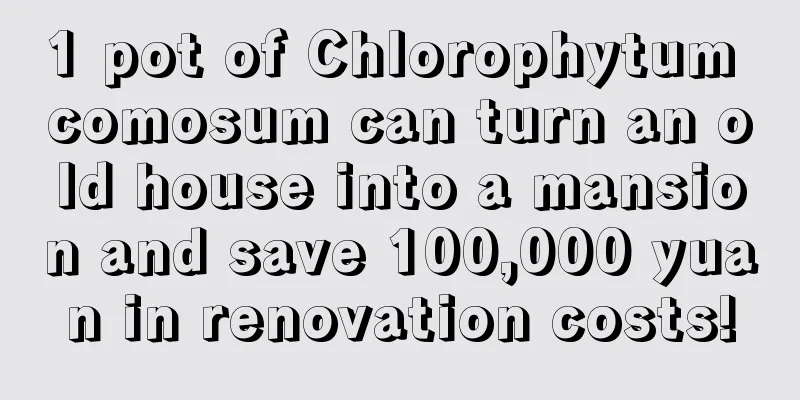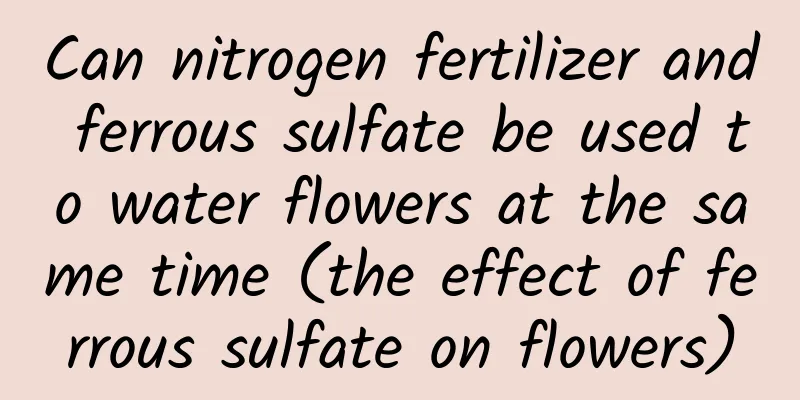What to do if the transplanted eggplant seedlings do not grow (reasons for slow growth of open-field eggplant seedlings)

Why do eggplant seedlings grow slowly?In addition to professional eggplant growers who have relatively rich experience in growing eggplant, some friends choose to grow some eggplant in their own vegetable gardens in order to save vegetable expenses. Not every friend who grows eggplants has experience. Some friends have planted eggplants that have not grown back for two weeks after the eggplant seedlings were planted. This phenomenon of eggplant seedlings not growing back is called "dead seedlings" or "old seedlings" . In fact, after the eggplants have been planted and have grown, they may not grow for a long time, or even change at all. Sometimes you may even see the eggplants shrinking, becoming thinner and thinner, and the leaves becoming wrinkled. If the water and fertilizer management is in place, then you need to pay attention to the root system of the eggplant. Because the eggplant does not grow for a long time after planting, it is mostly related to root discomfort or root damage. Some of the eggplant roots were damaged when they were plantedIf the root system of the eggplant is partially damaged before planting, the eggplant will grow slowly and not show any signs of growth . For example, before planting eggplant, if the taproot is short, the lateral roots are partially missing, and the capillary roots are sparse, the growth of the eggplant will be very poor. Eggplant is a plant whose roots easily enter the lignification process relatively early. Although its root system is well developed and the root mass is strong, the root regeneration ability of eggplant is very poor. If the eggplant's root system is completely missing, it will be difficult to transplant and survive. Even if more water, fertilizer and management are given, it generally will not be able to survive. Therefore, once the root system of the eggplant seedlings is partially damaged, the root regeneration ability of the eggplant is poor, and the eggplant plant is in a state of survival maintained by the remaining roots, the seedlings will recover slowly and will not grow after recovery. Eggplant root nestingIf the eggplant has root slumps when it is planted, the eggplant will not grow for a long time . For example, when the eggplant is planted, the main root bends upward and the lateral root tips point upward, which violates the growth law of the eggplant root system. There is a root nesting phenomenon, and the eggplant will inevitably show the phenomenon of slow seedling growth and no growth. Root nesting refers to an incorrect cultivation method in which the roots become tangled, knotted, clumped, bent, broken, or partially or completely inverted due to incorrect cultivation methods or improper operations during crop transplanting. After the eggplant roots are curled up, the roots cannot stretch naturally. Only the outer roots can come into contact with the soil. The roots that are curled up together cannot obtain nutrients and energy from the soil. Relying solely on the outer roots to absorb nutrients to maintain the nutritional growth of the entire plant will inevitably reduce the speed of eggplant seedling acclimatization and its normal growth after acclimatization; therefore, the phenomenon of no growth for a long time after planting occurs. The eggplant roots are not in contact with the soil when it is plantedIf the soil moisture is poor and the soil clods are large when the eggplants are planted, the eggplant roots will not be in solid contact with the soil and the seedlings may not grow well after acclimatization . The root system is not in contact with the soil. This means that during the eggplant planting process, there are large gaps between the soil. Although the surface soil is relatively flat, the soil particles covering the roots are larger, and the eggplant roots are suspended or partially exposed to the air. The eggplant roots cannot fully contact the soil; although some roots can absorb nutrients from the soil, most of the roots cannot find nutrient support. It is far from enough to rely on part of the root system to absorb nutrients to maintain the survival of eggplants. It is good enough to be able to successfully slow down the seedlings. Therefore, if the eggplant roots are not in contact with the soil, the eggplant will not grow for a long time. Eggplant roots are disturbed by pests and diseases after plantingIf the eggplant's root system is infected by pests and diseases after planting, or part of the root system loses the ability to absorb nutrients, or the root system is partially damaged, the eggplant will not grow for a long time after transplanting. For example, soon after eggplant is planted, its roots are infected by white grubs, mole crickets, silkworms, nematodes and soil-borne diseases such as root rot. If the eggplant's roots are partially bitten off by insect pests, and part of the roots lose their ability to absorb nutrients, the eggplant will grow slowly or stop growing, and the seedlings will wilt and die. Four ways to improve eggplants that don't grow after planting1. Apply rooting fungus solutionThe quality of root development is an important factor in determining the growth of eggplant. If the root system is well developed, the eggplant will grow fast and well. The root system develops poorly and the eggplant grows poorly and slowly. If the eggplant does not grow for a long time after planting, the situation can be improved by applying rooting agents. This will encourage the eggplant roots to take root early, grow roots early, and grow strong roots, so that the eggplant roots can enter the normal development track as soon as possible. In addition, there are a lot of rooting bacteria liquid for eggplant; you can use 1500 times diluted 2% indolebutyric acid and 0.2% inducer wettable powder to spray eggplant plants or directly irrigate the roots. We can also use 2.5% indolebutyric acid added to 2.5% naphthaleneacetic acid 250 times diluted for root irrigation or apply it with water. These rooting agents can stimulate the activity of eggplant root cells, promote root cell division, and promote early root differentiation. They can also increase the abundance of fibrous roots, which is conducive to the formation of large root groups and can significantly improve the growth rate and quality of eggplant. 2. Reasonable water and fertilizer managementAfter eggplants are planted, they grow slowly, grow poorly or not at all, which is also related to the proper water and fertilizer. After the eggplant is planted, it does not mean that watering more and more frequently will make the eggplant grow well, nor does it mean that less watering or no watering will be beneficial to the growth of eggplant. In other words, reasonable watering after the eggplant is planted is in line with the growth law of eggplant in the seedling stage. Eggplant is a crop that is not drought-tolerant. Poor soil moisture, barren soil, and lack of water will inhibit the eggplant's seedling growth rate and prevent the eggplant from entering the normal growth track. Eggplant is also a crop that is not tolerant to waterlogging. Its root system has certain requirements for soil oxygen content. If eggplant is watered frequently or flooded frequently, the water will squeeze the soil oxygen content, and the eggplant root system will not be able to breathe and metabolize, so the eggplant will grow slowly or stop growing. Generally speaking, eggplants should be watered enough when they are planted, and watered once on the second or third day, with small amounts of water being the main method. On the fourth or fifth day, water the seedlings once, with an appropriate amount. When entering the growth stage, water the eggplants appropriately and timely according to the degree of soil drought. 3. Strengthen tillage and loosen the soilAfter eggplants are planted, timely tillage, weeding and loosening the soil is also an important part of eggplant seedling management. There is an old saying that "hoeing eggplants once means fertilizer will come". There is also a saying that "when eggplants are hoeed, they will grow a lot even if they don't grow much". This means that during the eggplant seedling stage, through inter-row cultivation and weeding, the soil can be loosened to create a comfortable environment for the growth of eggplant, so that the eggplant can grow fast and well. Because the eggplant root system is in the growth and development stage during the seedling stage, loose soil is conducive to improving the soil oxygen content, which is conducive to the stretching and downward development of the eggplant main root, and the horizontal development of the lateral roots into the soil. Especially after watering eggplant, loosening the soil in time can prevent the formation of a compacted layer of soil, break up large soil particles, and promote close contact between the roots and the soil. This can prevent weeds from competing for soil nutrients and suppressing the growth of eggplant. Therefore, intertillage management is an important means to improve the growth of eggplant seedlings. 4. Sprinkle plant ash around eggplant plantsIf the eggplant seedlings do not grow for a long time, you can also spread wood ash to disinfect the soil, prevent the breeding of diseases, and prevent pests from gnawing at the eggplant roots. Wood ash is a common kitchen residue in our lives. It is the ash left after the burning of plant straw. Wood ash is not only a high-quality organic fertilizer, it also has the function of inhibiting bacteria and insects, disinfecting and removing eggs. Applying wood ash around the eggplant roots can not only kill diseases and pests in the soil, but also control wound flow and help the roots heal wounds. Moreover, wood ash is rich in phosphorus, potassium and comprehensive mineral elements, which can increase the looseness of the soil, enhance the physiological resistance of eggplant, promote the development and growth of eggplant roots, and promote the strength of eggplant stems. Therefore, spreading wood ash around the eggplant roots can help the eggplant resume its growth and enter a rapid growth and reproductive stage. 【Summarize】 Although the failure of eggplant to grow in the seedling stage is related to many factors, such as climate conditions, growth environment, temperature and humidity, soil quality and management level, which can all cause eggplant to grow slowly or not grow in the growth period, the development of the eggplant root system is the key factor for the failure of eggplant to grow after planting. |
<<: How to plant leek seeds and get good germination results (leek seed planting method and steps)
Recommend
How to eat Qingzhou peaches and what are their nutritional values?
1. How to eat 1. Eat raw: The best way to eat pea...
Ten taboos for raising grass carp
Grass carp, also known as silver carp, oil silver...
The language and legend of Viburnum
Flower Language Beautiful romance, perfect love, ...
Post-flowering treatment of hibiscus flowers
1. Prune the remaining flowers It is necessary an...
Cultivation methods and precautions of multi-headed chrysanthemum
1. Fertilization If you want to fertilize it, it ...
How many days does it take for coriander to sprout?
Coriander is a seasoning vegetable that many of o...
Breeding methods and precautions for Qianyu Crane
1. Maintenance methods 1. Soil: Crane truncatum g...
What to do if Phalaenopsis is frostbitten
1. Move indoors Phalaenopsis is suitable for grow...
How to prune trumpet creeper? Is it an evergreen plant?
1. How to prune trumpet creeper 1. Pruning during...
How to grow purple-leafed Oxalis
1. Adequate light Although it can tolerate partia...
Diseases and Pests of Viola serrata and Their Control
Diseases of summer pansy How much do you know abo...
How to prepare the soil in the flower pot and how to prepare the nutrient soil in the flower pot
Requirements for preparing flowerpot soil To prep...
Loquat growth environment conditions and characteristics
Loquat growth environment conditions and requirem...
Planting time of roses
Planting and management Generally, the best seaso...
Honey pomelo planting conditions and growth environment requirements
Honey pomelo planting conditions Honey pomelo pre...









